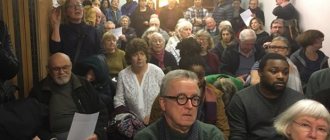According to Federal Law No. 176, a general meeting of owners of an apartment building can be organized not only through a personal meeting of residents, but also through absentee voting.
Holding an in-person meeting of homeowners is convenient due to the fact that it becomes easier to assemble the required quorum. Practice shows that not all residents of the house may be present at an in-person discussion at the appointed time, and absentee voting solves this problem.
In-person and absentee voting is carried out in two stages: a personal meeting of the owners and a subsequent survey conducted in absentia. The legislation has established clear rules for holding such meetings, but there are issues that only a specialist can explain. If you are not completely confident in your knowledge about voting, then it is better to clarify this with a professional.
Do you want to figure it out, but don’t have time to read the article? Lawyers will help
Entrust the task to professionals. Lawyers will complete the order at the cost you specify
41 lawyers on RTIGER.com can help with this issue
Solve the issue >
Concept
In-person and absentee voting is one option for collecting votes. Its main feature is a two-stage process for accepting ballots:
- The first part is the general meeting of MKD owners. Announcement and discussion of problems. At this stage, those residents who came to the meeting vote. Moreover, the presence of a quorum in this case does not matter, since voting does not end there.
- The second part is the voting of the remaining persons who did not come to the first stage. They vote on the same ballots, but outside the meeting. As a rule, the initiator of the event determines in advance the time frame during which the questionnaires will be received.
Reference! Only after these two stages have ended does the commission count the ballots and determine the quorum. If it is, then the voting is considered successfully completed.
Nuances of an absentee meeting without an in-person meeting
A door-to-door visit to the owners of residential premises to collect signatures, formalized as an event without visiting it, is protested by the Housing Code. The regulatory provisions of the Housing Code of Russia prohibit the execution of an absentee meeting of owners of apartment buildings without a preliminary in-person meeting format.
In the absence of an established quorum at general meetings of owners of a multi-storey building, expression of the will of citizens is allowed according to the in-person formula. This is done through questionnaires and the housing and communal services information system. However, voting must be preceded by a gathering with visiting citizens.
Watch the video: “Round table “State Information System for Housing and Communal Services (GIS Housing and Communal Services).”»
What else to read:
- Is it possible to discharge and evict a person through the court without his consent from a municipal apartment under a social tenancy agreement?
- Can they be evicted from a service (departmental) apartment in 2020 if there is no other housing - grounds, conditions, procedure for eviction according to the Housing Code of the Russian Federation
- The nuances of eviction from an apartment for debts on housing and utility payments in 2021 - can they be evicted for non-payment of housing and communal services (samples of documents)
- Can the owner forcibly sign out and evict a registered person from an apartment without his consent and presence - eviction to nowhere without the provision of other living quarters
Differences from other forms
This method of collecting votes is somewhat different from the in-person and absentee voting methods.
Differences from full-time:
- The owner of the living space may not appear at the meeting in person, but his vote will be taken into account if he takes a ballot and votes on the items on the agenda.
- The process may take several days as it may take some time to collect votes.
- If there is no quorum during a meeting in person, it is considered invalid. With absentee voting, the presence of residents with 50% of the votes at the first discussion of the issues is not at all necessary.
What is the difference from the correspondence form:
- In this case, people can choose: either come to the meeting in person and discuss the issues on the agenda, putting forward their proposals and asking the board questions of interest, or simply take a ballot and put a tick and sign.
- Absentee voting takes place in a shorter period of time: residents are given ballots, which are either filled out immediately and given to the person conducting the survey, or submitted to the HOA office at the appointed time.
If the meeting is held in person or in absentia, the initiative group will first need to hold an in-person meeting, and only then collect completed ballots.
What is "majority"?
Part 1 of Article 46 of the RF Housing Code states: “Decisions of the general meeting of owners of premises in an apartment building on issues put to vote are adopted by a of owners participating in this meeting , with the exception of those provided for in paragraph 1.1 of part 2 of the article 44 of this Code of decisions, which are made by more than fifty percent of the votes of the total number of votes of the owners of premises in an apartment building, and provided for in paragraphs 1, 1.1-1, 1.2, 2, 3, 3.1, 4.2, 4.3 of part 2 of Article 44 of this Code of decisions, which are adopted by a majority of at least two-thirds of the total number of votes of the owners of premises in an apartment building.”
This rule establishes that in order to make a decision on certain issues (provided for in paragraphs 1, 1.1, 1.1-1, 1.2, 2, 3, 3.1, 4.2, 4.3 of Part 2 of Article 44 of the RF Housing Code), a positive decision of the owners with a qualified majority of votes is required. At the same time, in order to make a decision on all other issues within the competence of the general meeting of premises owners, it is required that a positive decision be given by a majority of votes from the total number of votes of the owners participating in this meeting.
Let’s figure out what the term “majority” means in this case.
If we turn to explanatory dictionaries of the Russian language, then “majority” is defined in them as “the majority of someone or something” (Ozhegov’s explanatory dictionary), “a larger number, the majority” (Ushakov’s explanatory dictionary), “the majority of any whole, any group of objects” (Efremova’s explanatory dictionary). From the very definition of the word “majority” it follows that it means a certain part of something that is larger than another part. That is, the majority of a certain whole is more than half (more than 50%) of this whole.
Legal dictionaries (for example, the Encyclopedic Dictionary of Constitutional Law) define: “Majority is a concept used in constitutional law in connection with the conduct of various votes. There are categories of absolute, simple, relative and qualified voting. In electoral law: absolute voting is the election of a deputy or official subject to the condition that he receives 50% plus one vote of the total number of voters included in the electoral lists; simple B. - the candidate receiving more than half of the votes of the voters who took part in the voting..., relative B. - the winning candidate receiving a larger number of votes in relation to his rivals (“relatively” to his competitors, which is where the name of this type of B. comes from)..., qualified B. - election of a deputy or official by the highest number of votes (for example, 2/3, 3/4, etc.) of the total number of voters included in the lists, or of the number of voters who took part in the voting...”
As can be seen from the above options for the “majority” and the wording used in the housing legislation of the Russian Federation, in some cases a qualified majority is required to make decisions (for example, to make decisions on issues provided for in paragraphs 1, 1.1, 1.1-1, 1.2, 2, 3 , 3.1, 4.2, 4.3 of Part 2 of Article 44 of the RF Housing Code), and to make decisions on other issues, some other “majority” (absolute, relative or simple) is required. From the wording used in Part 1 of Article 46 of the Housing Code of the Russian Federation “Decisions of the general meeting ... are adopted by a majority of votes from the total number of votes of participating in this meeting ...” it follows that we are not talking about an absolute majority.
Thus, the task of establishing the “majority” that is discussed in the RF Housing Code comes down to choosing from a simple and relative majority. Actually, this is precisely what, as it turns out, is where difficulties arise not only among consumers of housing and communal services, but also among some specialists not only from management organizations and HOAs/housing cooperatives, but also from the prosecutor’s office and state housing supervision authorities (which is especially sad).
The use of a relative majority is possible only if there are several options for solving one issue, and the number of votes cast for each option is compared with each other. In this case, the decision option for which the largest number of votes was cast relative to other options is considered adopted.
Example 1:
Let the agenda indicate the question “To elect the chairman of the Council of an apartment building:” and indicate three options “Ivanov”, “Petrov”, “Sidorov”. 25% voted for Ivanov, 39% for Petrov, 32% for Sidorov, another 4% of ballots were declared invalid due to improper registration. In the example given, if a relative majority were acceptable, Petrov would be elected chairman of the House Council.
However, it is necessary to pay attention to the fact that the current norms of the housing legislation of the Russian Federation, regulating the procedure for conducting public consultations, establish that for each item on the agenda, only one decision option can be adopted, on which meeting participants can only vote “for” or “against” , “abstained” (subparagraph “c” of paragraph 18 of the Requirements for the preparation of minutes of general meetings of owners of premises in apartment buildings, approved by Order of the Ministry of Construction of Russia dated December 25, 2015 No. 937/pr).
That is, the situation described in the Example is unacceptable under current legislation. The agenda item for Example, in accordance with the law, could be formulated this way: “Elect Petrov as chairman of the Council of the apartment building,” and voting participants could only vote “for,” “against,” or “abstained,” and neither Sidorov nor Ivanov Such a formulation of the question could in no way become the chairman of the House Council.
Taking into account the fact that the housing legislation of the Russian Federation establishes the need to formulate the issue on the OSS agenda in such a way that voting participants could only vote “for”, “against” or “abstain”, there can be no talk of a relative majority during the OSS. That is, decisions on agenda items (except for issues provided for in paragraphs 1, 1.1, 1.1-1, 1.2, 2, 3, 3.1, 4.2, 4.3 of part 2 of article 44 of the RF Housing Code) are made by a simple majority - more than 50% of the participants meetings _
Example 2:
The general meeting of premises owners considered the issue of increasing the amount of maintenance fees from 25 rubles. per square meter up to 27 rubles. per square meter. The owners voted as follows: “for” - 45%, “against” - 33%, “abstained” - 22%, the management company declares that the decision has been made because there were more votes for its adoption than against its adoption, and more, than the number of votes of abstaining participants.
In fact, in the above Example, the decision was not made, since for it to be adopted it is necessary that the number of votes in favor be more than 50%.
If the use of a relative majority is considered acceptable, then several options for resolving one issue are possible. If more votes were cast “for” than “against” and “abstained” (not in total, but separately), but less than 50%, then from the point of view of the admissibility of using a relative majority, the decision will be considered adopted. If there are more votes “against” than “for” and “abstained”, then obviously the decision has not been made. And if the majority of votes were cast for the “abstain” option, then consider the decision to be “abstained”? Or how?
Already from this uncertainty it follows that a relative majority is not applicable in the case under consideration - the decision can either be made (if the number of votes in favor exceeds the total number of votes for all other options, that is, exceeds 50%), or not made (if 50% of the votes or less are given to the “for” option).
Additionally, it is worth noting that in addition to the options “for”, “against” and “abstained”, other voting options are possible. Let's give an example.
Example 3:
Owners with 51% of the votes (according to the Register of OSS Participants) are registered as full-time participants in the OSS. On the issue of choosing a new management organization, the votes were distributed as follows: “for” - 21%, “against” - 19.75%, “abstained” - 19.75%, ballots of owners holding another 19.75% of votes were declared invalid , the owners with 19.75% of the votes, despite participating in the meeting in person (registration, personal signatures in the register of participants), did not take part in the voting. As a result, the votes of the OSS participants were distributed as follows: “for” - 21%, “against” - 19.75%, “abstained” - 19.75%, “invalid.” - 19.75%, “did not vote” - 19.75%, total - 100%. If we consider it acceptable to use a relative majority, then since the number of votes given to the “for” option (21%) is greater than the number of votes for any other option, the decision has been made and a new management organization has been selected.
In fact, based on the norms of housing legislation, the decision in the given Example is considered not made. It is important to note that in this Example, the number of votes by which the decision was made is 21% of the votes of the participants, and 51% of the votes participate in the meeting, that is, the number of votes that were sufficient to make a positive decision is only 0.21 x 0 .51 x 100% = 10.71%. There have been repeated discussions about the fact that the current housing legislation of the Russian Federation allows only 26% of the votes to make positive decisions (if 51% of the votes participate in the meeting, 26% of the votes will account for more than half of those present), but the idea has never occurred to anyone that a positive decision under any circumstances, owners with only 11% of the votes (or even 10.71%) may accept. This is yet another confirmation that the use of a relative majority when conducting OSS is unacceptable and is not based on the law.
Based on the above, the term “majority of votes from the total number of votes taking part in the meeting” means more than half (more than 50%) of the votes of the number of votes participating in the meeting, that is, the decision is made only if more than 50% are given to the “for” option. votes of meeting participants .
Advantages and disadvantages
Attention! When choosing one or another option for holding a meeting, you need to take into account its advantages and disadvantages.
What are the advantages:
- The votes received in the first and second stages are added together. This means that this form of voting makes it possible to reach a quorum without any problems. This option for collecting votes is especially convenient when making decisions for which at least 2/3 of the votes must be cast.
- The second stage of voting (absentee) can be carried out using the Internet (through the GIS housing and communal services portal), which greatly simplifies the collection and counting of votes from residents.
Minuses:
- The process of holding a meeting and voting is quite long, since this form provides for a two-stage collection of decisions from the owners.
- Not all owners can appear to discuss the agenda, and this deprives them of the right to express their opinion on the proposals put forward.
Minutes of the meeting and its features
After the survey is completed, a protocol is drawn up. This official document must contain the following data:
- the date of the event, as well as the place where it took place (it is possible to indicate the exact address);
- form of conduct (full-time, part-time or part-time);
- address of the house, which can be classified as an apartment building;
- the number of apartment owners, as well as the number of votes they have;
- agenda (that is, the topic that will be discussed during such an event, this or that problematic issue);
- results of the survey;
- decisions that were formulated based on these results.
Please note: if voting at the general meeting is carried out in person, the so-called registration sheet must also be attached to the minutes. This sheet contains the following:
- personal data (full name) of those persons who will take part in the voting process;
- apartment number of the owners;
- the area of each person's home;
- the number of votes each participant has;
- data on title-type documentation for premises in the house.
If voting at the general meeting is carried out using the absentee method, all ballots of the persons who took part in it must be attached to it. The newsletter itself must contain the following:
- personal data (full name) of the participant;
- information about legal documentation;
- wording by vote (for, against, abstained).
Main stages of the procedure
Conducting a meeting consists of several stages and requires the preparation of accompanying documentation. Let's look at each stage in detail.
Preparation
The procedure for holding the event is described in detail in Order of the Ministry of Construction and Housing and Communal Services No. 411/pr . First of all, a list of issues is determined, an initiative group is formed (persons who will organize the event), and documentation is developed.
10 days before the date of the event, initiative persons must inform all residents about the meeting by written notification (a registered letter is sent to everyone). It is also possible to notify owners in other ways:
- delivery of a written message to each owner personally against signature;
- posting a notice in the house.
The letter must contain the following information:
- form of meeting;
- date and address of the first (in-person) stage;
- Full name of the initiator;
- list of topics;
- deadlines for voting in absentia;
- the place where you will need to submit your ballot.
IMPORTANT! In the first and second voting stages, the issues to be decided on must be the same.
Carrying out
The in-person voting stage includes: registration of the apartment owners who came, elections of the secretary and commission, as well as the chairman of the event.
Next, a list of issues under consideration is announced and their discussion takes place.
All event participants must submit completed questionnaires by the date determined in preparation for the event. The results are summed up only after the deadline for submitting ballots has passed.
If this document is submitted by the owner after the deadline, it will be considered invalid.
Summarizing
After a maximum of 10 days, the results are summed up and recorded in the protocol. At the same time, owners must be informed of the decisions made. Usually the initiative group posts the results in the entrance of the house or publishes them on its official website.
Absentee voting of owners
As a rule, a survey is conducted at a general meeting of apartment owners. And then a vote of residents follows. In particular, absentee voting is scheduled. In this case, the decision made by the owners is transmitted in writing to the place that is recorded in the notice of the general meeting of residents.
It is worth noting that the housing codification act does not regulate which general meeting (for example, regular or extraordinary) can be held according to a procedure such as absentee voting of residents. That is why it can be argued that absentee voting can be used for any type of this event.
In order to conduct a survey using absentee voting, you need to send a message to the apartment resident about planning such an event. The form of such news is written. When writing such a message, the appropriate form is used. The message form requires the following information:
- information about the person on whose initiative it is planned to hold a meeting of apartment residents;
- the form of holding such an event (that is, absentee voting by apartment owners);
- the date the decisions were made, as well as the address where they need to be sent;
- agenda.
In this case, the form for such voting should not contain information about the place and time of the event.
Bulletin: content and structure
A ballot must be used to collect votes. What does it consist of:
- Full name of the person and his address.
- Details of the document confirming his right to own the living space.
- Share in the apartment, square meters.
- List of questions with possible answers: “yes”, “no”, “abstained”.
- Number and signature.
This form of meeting makes it possible to personally attend a discussion of topical issues at home, while you can cast your vote in absentia. At the moment, this is the most convenient and effective option for holding meetings for both the initiative group and residents.
Stages of the event
The General Meeting of Owners (GMS) is preceded by information about the event and the gathering of property owners. Codified legislative housing act of the Russian Federation - Art. 45, indicates a mandatory meeting in the 2nd quarter of the current year.
Owners of apartment buildings also have the right to carry out extraordinary events if the initiator is not the management company, Art. 148. The execution of fees has several levels, which requires preliminary preparation of accompanying documents.
Preparation
It is necessary to clarify the OSS agenda and determine the category of voting. However, with a two-step process, the event plan must be the same for both types. The meeting place for the hearing must be selected and the time for voting - the option - must be determined. A notice about the upcoming general meeting of homeowners should be posted on the information module.
This is indicated by Order No. 411/pr of the Ministry of Construction of the Russian Federation. The event organizer will need protocol forms and a list of house owners. The execution of the meeting is described in detail by the Order of the Ministry of Construction. The organizer should determine the range of issues to be considered, establish an initiative unit that will take charge of the organization, and develop the necessary documentation.
Notification
The organizer must notify each apartment owner with an individual invitation signed by the citizen or post an information notice in an accessible place to read. This must be done 10 days before the convening of the meeting, as indicated in Art. 45 residential complex of Russia.
The notice reflects information about the following:
- organizer of the event, type of voting, address, date, time of collection;
- meeting agenda;
- the procedure for familiarizing those present with the papers presented at the meeting;
- the deadline for accepting questionnaires for the general meeting of owners of apartment buildings in person and in absentia;
- address where the results of the statement are stored.
When the execution of an event involves the expression of the will of citizens with presence and absence at the gathering, the notification must indicate two dates. One talks about the beginning of in-person voting, the other – the end of the validity period for accepting ballots.
The alternation of both stages of the referendum has not been established, therefore these types have the right to be performed alternately or in parallel. It is possible to find one form outside another. The last type implies that the start of making a decision without attending a meeting is set earlier than the date of the meeting with presence. The period for the final receipt of questionnaires, accordingly, is later than the full-time one.
Owner information
Only the ballot is used to count votes. According to Article 48 of the Housing Code of Russia, the decision of apartment owners in a referendum shall indicate the following data:
- full personal name of the citizen, his address of residence;
- number and series of the property document;
- share in the living space, square meters;
- list of questions with variations of answers;
- number and signature.
The information listed does not depend on the type of referendum.
The procedure for conducting the annual OSS of housing in an apartment building
Carrying out
When holding a meeting that provides for the absentee expression of will of residents of an apartment building, the organizer must provide the opportunity to evaluate the agenda items and indicate the period for submitting completed ballots. The latter reports the place of referral or option using the State Information System of Housing and Communal Services.
It is possible to transfer questionnaires to the OSS administrator before the expiration of the period provided for absentee voting, which corresponds to Art. No. 46 of the Code. The decision is considered relevant if more than half of the apartment owners took part. The exception is protocols that require the written expression of the majority of owners, as stated in Art. And .
Results of the meeting
After 10 days, maximum, the voting result is summed up, which is reflected in the protocol, and the residents of the house are immediately notified about it. The decision is posted on the information module or published on its own portal.
The document of the general meeting is drawn up in a protocol, as stated in Article 46 of the mentioned codified act. The form is not approved at the state level, but it can be taken from the draft Ministry Order.
The organizer of the meeting provides the originals of the decisions along with the minutes of the meeting to the management company or HOA no later than ten days after the end of the meeting. The decision made in paper or electronic form is transferred to the State Property Committee.
What is included in the homeowners' newsletter and how do I fill it out?
The absentee voting ballot is drawn up on an A4 sheet. The leaf should be white.
Mostly, you need to print the ballot on a computer.
- The title of the document is indicated in the header.
- Next is the address and location of the house whose residents are being interviewed.
- A line is left to enter the initials of the citizen to whom the document was presented.
- Leave an empty space for entering the passport details of the homeowners.
- The place of registration of the citizen is indicated.
- The total area of the property occupied by the owner is indicated.
- The procedure for counting votes at the meeting is established.
- After this, the question is indicated in the thesis form.
- Below are the answer options. There is a dash next to each answer option. The option you choose should be marked with a tick or plus sign.
- A citizen can write on the form in clear handwriting, preferably with a black or blue ballpoint pen.
- There may be several questions, so be sure to turn the form over.
- Below is the date, as well as the signature of the person who gave their answers.
If the decision to choose one or another answer was made by an authorized person for the owner, it is necessary to indicate a document that is a notarized power of attorney with details.
You must also present a power of attorney when submitting your ballot.






